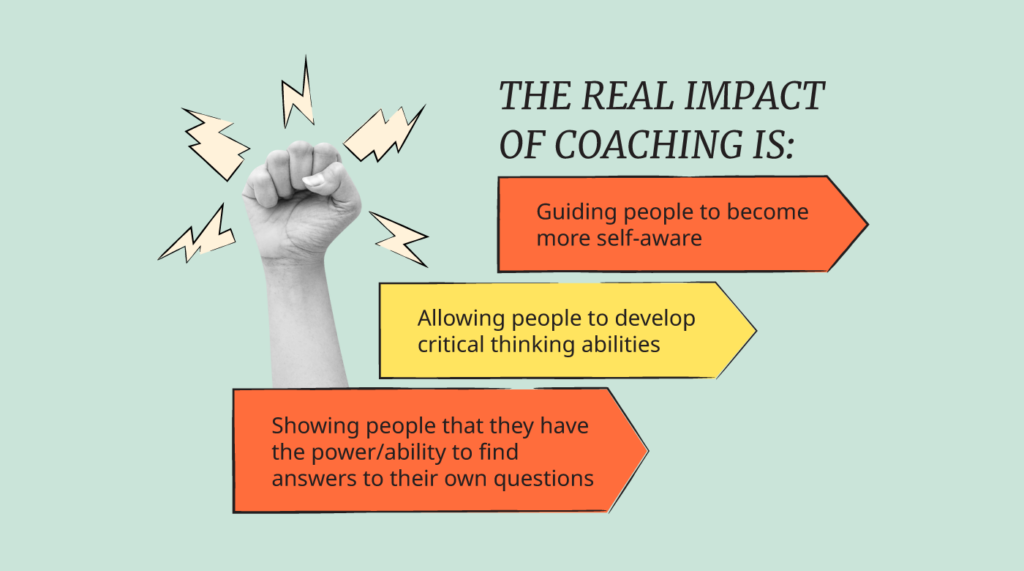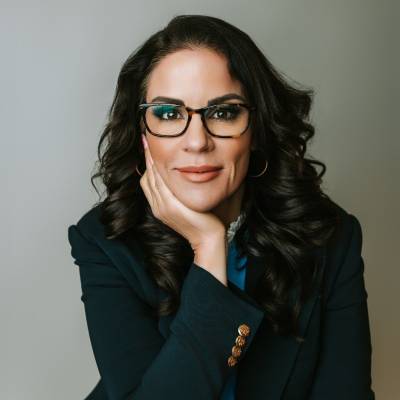As a manager or even individual contributor, you want to get the best out of your team members. If they succeed then so do you, and you can move up the ranks together.
To that end, it’s worth taking some time to learn the art of coaching because, let’s face it, you probably haven’t received much training on this yet and the potential benefits are enormous.
A study by the International Personnel Management Association found that ordinary training typically increases productivity by 22%, while training combined with coaching increases productivity by 88%.
A little coaching can really help change someone’s mindset and put them on the path to better performance.
Here we’ll cover:
- What Is Coaching In The Workplace?
- Essential Coaching Skills
- Coaching And Feedback
- How Coaching Can Help You With Difficult Employees
- Coaching Session, The GROW Technique
First up…
What is coaching in the workplace?
Coaching is a method of helping someone to set and achieve goals without explicitly telling them what to do. Instead, you help guide them toward their own conclusions.
This is different to management which is, as you’re aware, focused on delivery. Setting goals, making timelines, delegating tasks, developing processes and strategies, meetings (lots of those), conflict resolution, problem-solving, performance management, giving feedback.
Management is directive in nature, meaning that you’re telling people what to do and when. And sometimes that’s enough. Your people know what they’re doing and require minimal support.
But what if they need more support, either because they ask you or you recognize areas for improvement? Perhaps someone seems unmotivated or you think they might be stagnating in their role.
Well, this is a situation where it’s beneficial to switch from manager to coach. As a coach, your job isn’t to tell someone what to do, it’s to help them identify areas for development and set them down the path.
As leadership coach Lisa Martin puts it “You’re the limoncello in the lemon martini!” (meaning, you’re a small catalyst that helps someone to see what they need to see).
Coaches don’t tell, they guide. The aim isn’t to provide all the answers, it’s to play the occasionally infuriating role of questioner and help them find their own solutions.
Related Read: Why You Feel Unmotivated At Work And How To Feel Inspired Again
The most essential coaching skills
If you’re reading this I’m willing to bet a taco that you’re interested in people and their development, and that’s fundamental to the whole coaching mentality!
But there are two particular skills you can hone to become an effective coach:
Curiosity—asking questions
Coaching, as we’ve covered, isn’t about telling people what to do. It’s understanding what they need to know and then showing them the way.
Asking questions will help you to:
- Understand motivators
- Discover new ideas
- Upskill team members
- Increase employee engagement.
It will help whoever you’re coaching to:
- Identify areas of untapped potential
- Explore solutions to problems
- Set personal development goals
- Find the motivation to improve.
Some powerful coaching questions:
- What did you like about that project?
- What would you have done differently?
- What do you see as the next step in your career?
- What steps could you take to improve next time?
- What resources do you need?
- Who else can help you with that?
- What resources are available to you?
- How can you find out more about it?
- When would you like to achieve that by?
As you can see, the best questions to ask are open ones, beginning with what, how, when, who, where.
Asking these kinds of questions leads to a greater sense of ownership and empowerment than if you just tell someone what to do. Also, curiosity is a future proof skill that will serve you well throughout your career, so look to keep alive every chance you get.
For a more extensive list of powerful questions, check out this handy resource from the Co-Active training institute.
Active listening
When you’re coaching someone your entire focus needs to be on them.
Active listening is the ability to tune into the words of the individual and tune out every other noise and distraction.
Closing off notifications, closing your computer (if in person), or finding a quiet place to have a meaningful connection will aid in actively listening.
Here's a simple framework for active listening:
- Listen intently by removing distractions
- Pass no judgment on what you’re hearing
- Reflect on what you heard
- Clarify if needed by asking open-ended questions
- Summarize what you heard
- Share your thoughts, perspective, and insights.
Related Read: 7 Wellbeing Trends Of 2023 To Consider For Healthier, Happier Employees
Coaching and feedback
A quick note on coaching and feedback.
As a manager, a crucial part of your job is giving feedback. But this isn’t coaching.
Feedback is what has happened in the past, but coaching is future-focused.
An example of feedback following a sales call: “that was a good call Finn, but you should have questioned them further about their challenges surrounding implementation.”
An example of coaching following that call would be “Finn, how did you feel that call went? What could have gone better? If anything could have gone better, how would you have approached it?”
Knowing when to give feedback and when to coach is a great skill to master, and you may need to combine the two in the same conversation.
After giving critical feedback, you might want to try asking an open-ended coaching question to help someone brainstorm ideas for performing a task better next time.
“Finn, you missed an opportunity by not going deeper on the implementation challenges [feedback]. How can you make sure you spot these opportunities next time? [coaching]”
Alternatively, you might want to start with coaching and, if you don’t get what you wanted, switch to feedback.
For tips on how to give, and receive, feedback, check out Matt Gould’s excellent podcast, “Thanks, Tell Me More”
How coaching can help you with difficult employees
Difficult employees who exhibit bad behaviors aren’t lost causes. Part of the role of a coach is to help people unlock their potential.
Some powerful questions to ask:
- How do you think you are performing?
- What's holding you back?
- What does success look like?
- How can you contribute?
- What needs to change in order for you to excel?
A great example here is a story involving one of my favorite footballers (soccer players, I’m British), Robin van Persie, and my favorite football coach, Arsene Wenger.
Van Persie is one of the greatest Dutch footballers of all time, but he arrived at Arsenal FC under Arsene Wenger as a hot-headed youth who found it difficult to integrate with the team.
Wenger saw his abilities but didn’t like his attitude, so he didn’t select him for games. Van Persie, miffed at not getting the playing time he thought he deserved, spoke to Wenger and asked him why he wasn’t playing more.
Wenger said to him “Robin, you have to ask yourself why you're not the top player yet. Write down for yourself what your qualities are right now and also write down which qualities you think you still need to improve.”
He didn’t give him all the answers, he acted the supreme coach he is and encouraged his player to work it out for himself.
Van Persie developed into a superstar and is now a coach as well.
Running a coaching session, the GROW technique
Coaching is best carried out when time’s put aside for an in-depth conversation without distractions.
Consequently, it’s worth setting aside time for a 1:1 coaching session with your team members on a monthly or quarterly basis to delve into any issues or career aspirations.
GROW is a popular 4-step model for focusing a coaching session:
- Goals
- Reality
- Options
- Willingness
These allow you to guide the conversation like a journey.
Step one: Goals
The first step in the model is helping someone establish where they’d like to go i.e., setting some goals.
The SMART framework (specific, measurable, achievable, relevant, timebound) is a handy framework for this.
SMART goal example: “Gain promotion to senior designer in 1 year”.
Some questions to ask:
- What would you like to accomplish?
- Why would you like to achieve this goal?
- How does this goal fit in with the team’s objectives?
- What is the ideal outcome?
- How will you know when you’ve achieved your goal?
Step two: Reality
Next it’s time to take stock of the current situation and, in doing so, establish a starting point to start building toward their goal.
This is an important step because it helps identify any information they may missing in order to reach their goal.
Questions to ask:
- What is happening now (what, who, when, and how often)? What is the effect or result of this?
- Have you already made any progress toward your goal?
- What are any barriers stopping you from reaching your goal?
- Does this goal conflict with any other goals or objectives?
Step three: Options
Now you have a goal and the lay of the land, it’s time to brainstorm to help generate available solutions for reaching the goal i.e., how to get from A-B.
Of course, you can use your knowledge to make suggestions, but avoid making the decisions for them.
- What options are available for you?
- What else could you do?
- What’s worked for you so far?
- What do you need to stop doing in order to achieve this goal?
- If this blocker was removed, would that change things?
Related read: Best Brainstorming Tools for Sparking Creativity
Step four: Willingness
The final stage is to get your team member to commit to specific actions to move forward towards their goal. This helps establish willingness and motivation.
- What are your next steps?
- On a scale of one to 10, how likely is your plan to succeed?
- What would it take to make it a 10?
- What support do you need?
- What will happen if you don’t do this?
At the very end, set a date to review progress, this will provide accountability and allow for adjustments to the plan.
Using 360 feedback
360 feedback, or 360 reviews, are often used by professional coaches as a starting point for coaching.
A 360 review gathers feedback from managers, peers, and subordinates to provide a well-rounded assessment of someone’s skills and qualities.
You can guide the person through the feedback gathered in your 1:1 to help the coachee find their development focus.
The ultimate aim of coaching
The ultimate aim of coaching is to create great self-coaches!
Arsene Wenger managed to coach Robin van Persie to become not only a great player but to eventually transition into coaching and help develop the next generation.
Somewhere along the development journey, people will start asking themselves and others the coaching questions unprompted. Then, before you know it, you have a coaching culture!

Some more resources to help you to develop your coaching and leadership skills:
- Best coaching courses
- Co-Active Coaching: Changing Business, Transforming Lives
- The Coaching Habit: Say Less And Ask More
- The Making of a Manager: What to Do When Everyone Looks To You
- 5 Coaching Skills Leaders Can Use To Navigate Change
- How To Listen Better, A Look At The Different Levels Of Listening
- Leadership Coaching: Become A More Rounded Leader
- How To Cultivate A Strong Workplace Culture With Coaching (with Lisa Martin)





